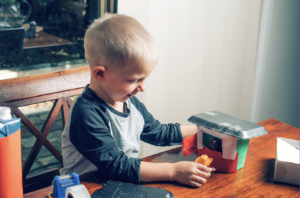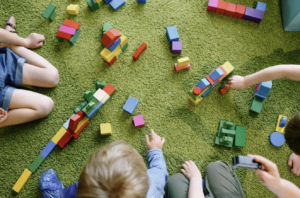Social Communication: Harnessing Natural Opportunities
Let’s meet 5 year old Johnny.. A vibrant, playful boy who likes chasing his brothers and watching cartoons. Johnny’s parents, Tim and Laura are worried that sometimes Johnny seems to find it difficult to talk with other kids his age. As they watch him with his peers, they notice that he finds it hard to start playing with other children his age, and he can struggle to get his ideas across or negotiate in games, which can lead to tears.

So… how can a Speech Pathologist and Occupational Therapist help?
Before answering this question, let’s discuss some differences in terminology.
Social skills vs social communication. One word makes all the difference.
Social skills:
Previous, outdated research might have suggested we teach Johnny a set of “skills” to fit into society such as not fidgeting, maintaining eye contact etc.
Social communication:
But the current research is challenging the idea that Johnny can be “fixed” with a set of skills that often aren’t meaningful to a person.
Social communication rejects the idea of ‘curing’ a person or ‘changing’ the way they live.
Rather, social communication is about supporting individuals to connect with others in a way that celebrates their individuality.
By extension, therapy targeting social communication seeks to support individuals to be able to make meaningful connections with others in an authentic way.
Let’s come back to thinking about Johnny.
Johnny’s teacher reports that Johnny is “having trouble” playing with his peers because he snatches toys from others.
A social skills goal might have been “for Johnny to keep his hands to himself”. While there is merit behind the intention of this goal, as therapists, we need to consider what the message Johnny is trying to convey behind his “snatching”.
In other words, a social communication goal might support Johnny to advocate for what he wants in a way that supports his engagement with others.

From an Occupational Therapist perspective, a social communication goal may be around supporting Johnny to identify what he wants, and to make a plan that allows him to use a desired toy.
From a Speech Pathology perspective, a social communication goal might be to support Johnny to get someone’s attention and use specific vocabulary to advocate for what he wants (e.g. saying “I want the orange ball” rather than “I want that”).
In practice, a social communication session with Johnny’s Occupational Therapist (OT) and Speech Pathologist (SP) targeting these goals might look like this.
Social communication sessions with Occupational Therapists and Speech Pathologists reject the idea of a ‘one size fits all’ approach where a child is taught a checklist of skills to ‘fit in’. Instead, social communication sessions harness naturally occurring opportunities to facilitate meaningful, authentic interactions.
If you would like to discuss how Speech Pathology and Occupational Therapy might be able to support your child or young person, contact the clinic to book a Client Journey Planning sessions, and our team would love to support your further.
Written by


Robbie Corgat, Speech Pathologist & Kiara Moodley, Occupational Therapist
May 2024.
